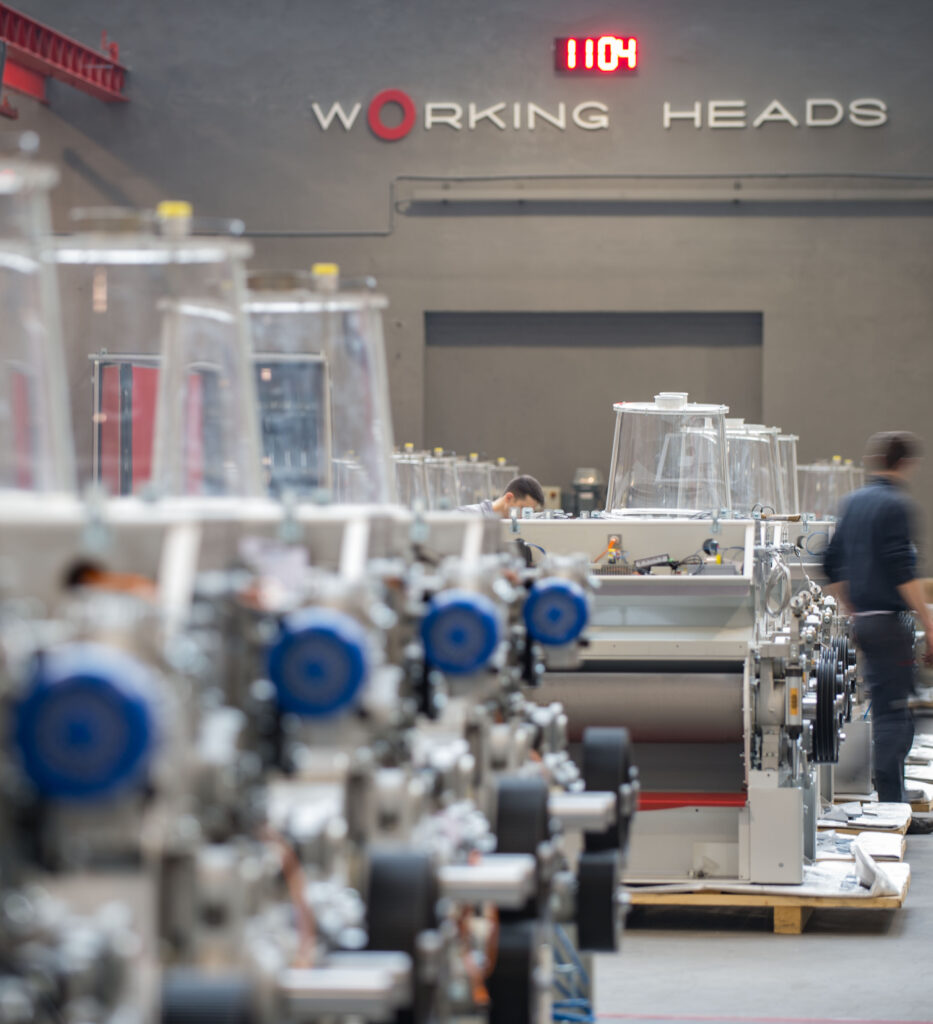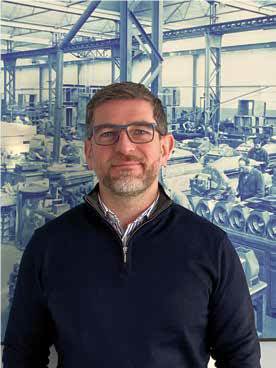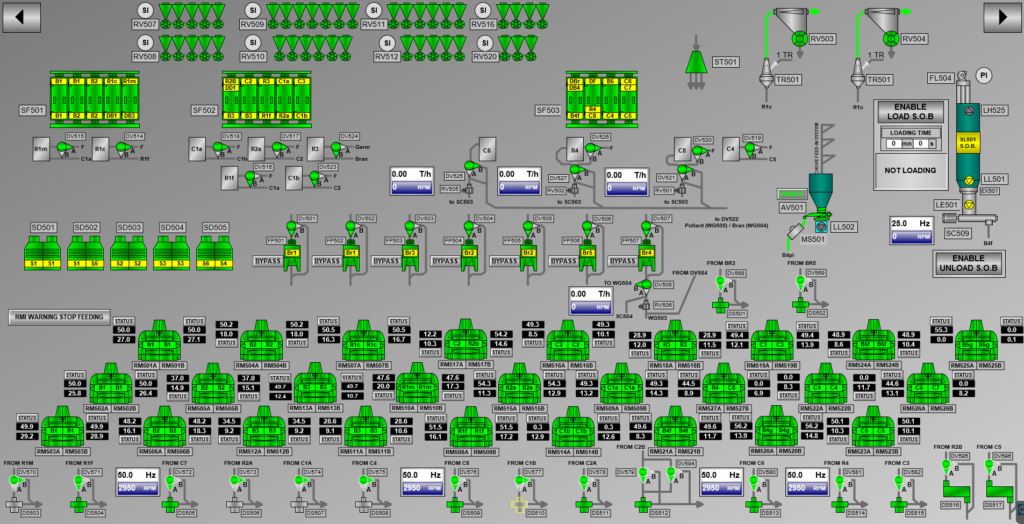The technological evolution of Ocrim has always prioritised one goal, that of streamlining production, reducing system downtime to a minimum. We moved from manually operated to semi-manual and finally automated solutions, ensuring high safety standards. The challenge still continues today and design innovation resorts more and more to artificial intelligence to continue improving and streamlining production processes. In this field, the partnership between Ocrim and Siemens has made it possible to offer integrated solutions that stand out by significance and efficiency. But there is a new frontier that the two companies have recently conquered – a virtual technological solution.
Elisa Maranzana explains it in this article published in the September-October 2023 issue of ÈUREKA! which we reproduce in full.
VIRTUAL ARCHITECTURE FOR THE FLOUR OF THE FUTURE

To increase the reliability of processes, reduce the negative impacts in the event of disaster recovery, and make control systems more scalable, some of Ocrim’s customers have requested a state-of-the-art virtual technological solution. The well-known manufacturer of milling plants has been able to fulfil this request thanks to the profitable cooperation with Siemens, and specifically with the Customer Services business unit of Digital Industries. Among the most current issues that concern industrial automation, the potential and ways of using artificial intelligence to benefit production is the subject of much debate. Many manufacturers of machines and plants indeed aim at producing solutions where artificial intelligence provides added value to production, simplifying the operators’ work. The topic is also garnering interest from sectors that until now were used to thinking in much more traditional terms, such as companies that produce milling plants. An example of this new approach is that of Ocrim, founded in 1945, which throughout its history has pursued very significant technological developments, allowing it to conquer a leading position worldwide. This was thanks to the foresight of a management team that has always considered technological innovation as key, identifying high-level partners and initiating profitable collaborations. As was the case with Siemens, with which Ocrim started collaborating thirty years ago.
A NEW CHALLENGE

With an annual yearly turnover of roughly 80 million Euro, headquartered in Cremona, Ocrim designs and produces turnkey milling systems around the world and is a reliable partner also in the supply of individual machines. “We are capable of offering ad hoc solutions to the end customer,” said Paolo Molinari, who has been with the company for 25 years and is now Head of the electronic & automation department, “and we set up the facility and lay out the grain stocking and processing, tailored to the customer’s needs. Therefore, we do not offer a finished product following standardised production criteria, but we recommend to customers the best solution based on their specific operational needs as well as on market requirements.”
INCREASINGLY AMBITIOUS GOALS
The main mission of a milling system is to streamline production. “When I set up a system with a capacity of 400 tonnes a day,” Molinari continues, “I must be able to assure this productivity, limiting downtime due to the most diverse reasons to the bare minimum. Therefore, I must ensure reliability and continuity, allowing the operator to make the necessary production changes as quickly as possible.” Until some time ago, the main challenge for manufacturers of milling systems consisted in switching from semi-manual, if not fully manual, solutions to automated production.

This effort led to the introduction of solutions capable of managing programmed cycles and automatic interlocks to relieve the operator of just-in-time operations in the event of alarms, thereby assuring high safety standards. However, according to Molinari, the objective today is to produce and supply plants with control systems that, despite not being fully autonomous yet, also for safety reasons, extensively use artificial intelligence features to broaden and simplify control and operation. These challenges are far from simple, yer over the years Ocrim has been able to tackle them successfully thanks to the invaluable collaboration with Siemens.
AN EXTENSIVE COOPERATION
The technological partnership between Ocrim e Siemens, and specifically with the Factory Automation Business Unit of Digital Industries, started thirty years ago. “Siemens has always been a leader in process automation and at the time it already provided a wide range of applications, which allowed it to be a one-stop shop with a single modus operandi,” says Molinari. “Its software products, which over time were collected in a single platform, had consistent user features across all products. In a complex setting such as ours, this consistency of action provided a remarkable added value.” Starting from the concrete technological requirements of some of its customers based in the Far East, Ocrim’s collaboration with Siemens broadened two years ago, to also include the Customer Services business unit. “With a view to designing new plants and upgrading existing ones, some customers, especially in the Far East”, adds Molinari, “started asking us to migrate from a clientserver solution on physical machines to a virtualised solution with regard to process automation and production control.” The main goal of these concerns was indeed to maximise process reliability thanks to more efficient control, while reducing impacts in the event of disaster recovery. In the event of damage to a hardware component due to extreme causes, this kind of solution would indeed make it possible to significantly reduce system downtime, with the option of restoring the IT infrastructure even remotely by Ocrim technicians. “These customers,” Molinari explains, “were asking for a scalable solution, against an investment also aimed at extending the capacity of the installation, where they were planning to obtain space to install new production lines. At the same time, they also needed the highest degree of reliability from the point of view of cybersecurity as well as in terms of hardware and software.”
A COMPREHENSIVE SOLUTION

In the process industry, virtualising essentially means breaking the link between the IT part, made up of operating systems and software applications, and the physical hardware. “The trend,” explains Pasquale Santamaria, After Sales Service Specialist at Siemens, “is to provide the operating systems and application software in the form of virtual machines, managed by a hypervisor on interchangeable hardware. And therefore to consider less important the physical system on which the software runs, bypassing a type of control that today is proving to be increasingly expensive in terms of energy, space and obsolescence management.” In order to deal with this need, for some years now Siemens has been offering Sivaas (Simatic Virtualization as a Service), a solution that seeks to meet the essential requirements of this type of architecture, with the highest efficiency and cost effectiveness. Sivaas also makes it possible to deal more easily with disaster recovery situations, because the ease and speed in performing backups and subsequently restoring virtualised systems ensure the installation immediately resumes operations in the event of any problems. “In our specific case,” Molinari concluded, “the support provided by Siemens and its team was invaluable, because it enabled us to perfectly identify, from the point of view of hardware as well as software, the technological assets to be used in these installations and to choose them also based on the needs and computing power calibrated on the lines we were going to control. This has also enabled us to transfer the right investments to the end customer.”


